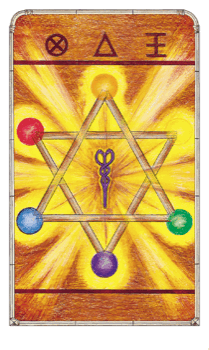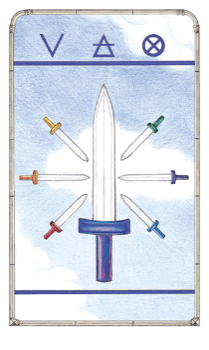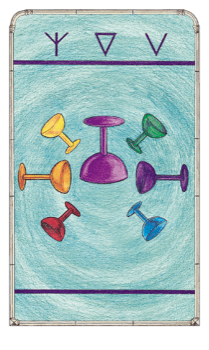 Send
comments about this page
Send
comments about this page Last update: 6 Sep 2022
Similarly, the Pythagoreans call the Heptad "Athena", for like Her the Heptad is born of neither mother (Even) nor father (Odd), but is a Second Monad, sprung like Her from the Source, the First Monad, the Head of the Father. As Athena, the Forager (Agelaia), gathers disparate things and brings them together in one place, so the Heptad gathers together many disparate influences and from them makes a new Monad, a new Beginning, a new Principle of Generation.
Likewise the Pythagoreans call the Heptad a "Flock" (Agelos), for it is a Cluster of multiple forces, as when the Seven Planets act at once, each exerting Its own influence. This Cluster of Forces is an unsymmetrical and unstable equilibrium, and so the Passive Heptad has a delicate structure and represents an ill-defined situation. Thus the slightest perturbation may cause a sudden, unpredictable change, for whichever force happens to dominate at that moment may thereafter prevail over the others. Therefore, the Pythagoreans call the Heptad "Chance," since it represents the Critical Point, the Crisis, the Coincidence, and thereby the Impulse to the Second Creation and thus the Second Completion, which constitutes Full Embodiment.
The Heptad itself is Victory and Fulfillment, for it brings many things to completion. The Heptad is a return to the Unity and Wholeness of the Monad. As there is a Descending Triadic Path, from Unity (1), through Goal (2), to Achievement (3) and finally to Order (4); so also is there an Ascending Triadic Path, from Order (4), through Crisis (5), to Reconciliation (6) and finally to Hidden Unity (7). In this way too a person's life is brought to completion in Seven Stages (corresponding to the Planets), and the Seventh Stage brings one to the Threshold of Rebirth. So also is the Heptad the Root of all Cycles, of the moon, of women, of tones, of weeks, et cetera.
The Heptad is the Seventh Door, the Gateway to Initiation and Rebirth, for it is both the Completion and the New Beginning (the Second Monad). Such was Inanna's (Ishtar's) Descent to the Underworld, which was through Seven Gates. Further, the First Tetrad (1, 2, 3, 4) is the Nigredo, the Descent to Matter; the Second Tetrad (4, 5, 6, 7) is the Albedo, the Ascent to Spirit; but the Third Tetrad (7, 8, 9, 10) is the Rubedo, the Descent of the Spirit into Matter. This is what the Alchemists tell us.
There are two Symbols of the Heptad, for it is seven asymmetrically arrayed forces, converging on a point, the Seven-Rayed Star. Or it is the Monad blazing again in the Center of the Hexad, which is therefore the Seven Places: Center, Above, Below and the other Four. Thus does the Monad of the Rational Soul blaze in the Hexad of the Living Animal, for Plato said the Soul has Seven Numbers.
The Heptad is the Complete Person, the Embodied Spirit, for it is the Three Psychical Elements (Cognition, Spirit and Appetite), and the Four Material Elements. (And so there are Three Spiritual Virtues and Four Practical Virtues.) The Greek Numeral for the Heptad is Z, which stands for Zao (Zeta-Alpha-Omega = to Live), for the Heptad is Life, since it is the Offspring of the first Actual (vs. Potential) Numbers that are Odd and Even: Father (3) and Mother (4) and Child (7).
The Heptad controls all material things, for it comprises the Four Elements and the Three Means that bind them together, Fire to Air, Air to Water and Water to Earth, and these Means govern the elemental changes. Thus the elements Fire, Air, Water and Earth form a geometric progression, for as Earth is to Air so is Water to Fire; and as Earth is to Water so is Air to Fire. Look at the triangular figures, their Alchemical Signs, and you will see.
In summary, the Heptad represents an unstable situation; either a new force upsetting the harmony and balance of the Hexad, or a new impulse arising in its center. There are many possible outcomes. If the opportunity is missed, another cycle of seven is to be expected, but if the critical moment is seized, the result will be a rebirth into a new transformative process.




Image: Six staffs arranged in a hexagram (as for the Six of Wands), except that its center is occupied by a glowing, purple caduceus, which sends fiery rays into the dark around the hexagram.
Commentary: The caduceus represents entry to the mysteries, since it is the staff of the Psychopompos (Guide of Souls); it shows the way in the darkness. It also represents the Hidden Monad in the center and Mercury, the third celestial element (after Sun/Moon = gold/silver = sulphur/salt) beyond the four mundane elements. Purple is both an imperial color and a color of the underworld; it is associated with confidence, truth and justice (Cooper s.v. Colours).
Image: A single, large upright sword with a purple hilt stands upright amongst six swords, three to each side, with their points directed inward. The horizontal swords are a little larger than the diagonal. From top to bottom, the hilts of the swords on the left are yellow, orange and red, those on the right, green, violet and blue.
Commentary: The upright sword represents the Hidden Monad, but also the leap to commitment cutting through the previous worldview (represented by the Hexad). It represents the third celestial element (Mercury), as the large, horizontal swords represent the Sun and Moon (gold and silver, sulphur and salt), the poles of the Cosmic Axis (orange and violet); the smaller four represent the mundane elements (yellow, green, blue, red). The swords are directed inward to represent paralysis and conflicting influences, pushing you first one way, then another.
Image: Six cups, three to each side, around a large, inverted purple cup. The two horizontal cups have their mouths toward the center and are larger than the four diagonal cups, which have their mouths to the outside. From top to bottom, the cups on the left are yellow, orange and red, those on the right, green, violet and blue.
Commentary: The two larger, horizontal cups represent the Sun and Moon (gold and silver, sulphur and salt), the four smaller, diagonal cups the mundane elements. They all represent opportunities. The inverted cup (Mercury) represents the emptying or exhaustion of the old and the need for new fulfillment.
Image: Six pentacles, three to each side, around a large purple pentacle engraved with the symbol for Mercury. The others are engraved with the symbols of the other six planets: clockwise from the left, Sun, Jupiter, Venus, Moon, Saturn, Mars; their colors are orange, yellow, green, violet, dark blue, red. Yellow-green background.
Commentary: According to Ptolemy (Tetr. I.4), earth corresponds with Mars (because drying), water with Saturn (cold), air with Venus (wet), and fire with Jupiter (hot). Therefore, proceeding clockwise from the upper right, we have the Way of the Earth, through Water to the Abyss, and on the right, the Way of the Air, through Fire to the Heavens. The two alchemical seeds (Sun/Moon or gold/silver) stand on either side of the four mundane elements in their usual square of opposition. Mercury stands in the center, mediating all oppositions, but also disrupting the structure of the Hexad.
 Send
comments about this page
Send
comments about this page
Last update:
6 Sep 2022